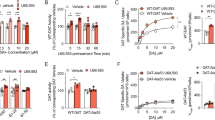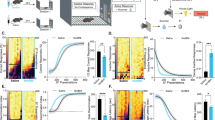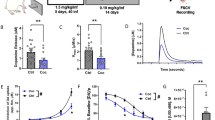Abstract
Brain kappa-opioid receptors (KORs) are implicated in states of motivation and emotion. Activation of KORs negatively regulates mesolimbic dopamine (DA) neurons, and KOR agonists produce depressive-like behavioral effects. To further evaluate how KOR function affects behavior, we developed mutant mice in which exon 3 of the KOR gene (Oprk1) was flanked with Cre-lox recombination (loxP) sites. By breeding these mice with lines that express Cre-recombinase (Cre) in early embryogenesis (EIIa-Cre) or only in DA neurons (dopamine transporter (DAT)-Cre), we developed constitutive KOR knockouts (KOR−/−) and conditional knockouts that lack KORs in DA-containing neurons (DAT-KORlox/lox). Autoradiography demonstrated complete ablation of KOR binding in the KOR−/− mutants, and reduced binding in the DAT-KORlox/lox mutants. Quantitative reverse transcription PCR (qPCR) studies confirmed that KOR mRNA is undetectable in the constitutive mutants and reduced in the midbrain DA systems of the conditional mutants. Behavioral characterization demonstrated that these mutant lines do not differ from controls in metrics, including hearing, vision, weight, and locomotor activity. Whereas KOR−/− mice appeared normal in the open field and light/dark box tests, DAT-KORlox/lox mice showed reduced anxiety-like behavior, an effect that is broadly consistent with previously reported effects of KOR antagonists. Sensitization to the locomotor-stimulating effects of cocaine appeared normal in KOR−/− mutants, but was exaggerated in DAT-KORlox/lox mutants. Increased sensitivity to cocaine in the DAT-KORlox/lox mutants is consistent with a role for KORs in negative regulation of DA function, whereas the lack of differences in the KOR−/− mutants suggests compensatory adaptations after constitutive receptor ablation. These mouse lines may be useful in future studies of KOR function.
Similar content being viewed by others
Log in or create a free account to read this content
Gain free access to this article, as well as selected content from this journal and more on nature.com
or
References
Beardsley PM, Howard JL, Shelton KL, Carroll FI (2005). Differential effects of the novel kappa opioid receptor antagonist, JDTic, on reinstatement of cocaine-seeking induced by footshock stressors vs cocaine primes and its antidepressant-like effects in rats. Psychopharmacology 183: 118–126.
Berton O, McClung CA, Dileone RJ, Krishnan V, Renthal W, Russo SJ et al (2006). Essential role of BDNF in the mesolimbic dopamine pathway in social defeat stress. Science 311: 864–868.
Bevins RA (2005). The reference-dose place conditioning procedure yields a graded dose-effect function. Int J Comp Psychol 18: 101–111.
Bruchas MR, Chavkin C (2010). Kinase cascades and ligand-directed signaling at the kappa opioid receptor. Psychopharmacology 210: 137–147.
Bruchas MR, Land BB, Chavkin C (2010). The dynorphin/kappa opioid system as a modulator of stress-induced and pro-addictive behaviors. Brain Res 1314: 44–55.
Bruchas MR, Schindler AG, Shankar H, Messinger DI, Miyatake M, Land BB et al (2011). Selective p38alpha MAPK deletion in serotonergic neurons produces stress resilience in models of depression and addiction. Neuron 71: 498–511.
Carlezon WA, Beguin C, DiNieri JA, Baumann MH, Richards MR, Todtenkopf MS et al (2006). Depressive-like effects of the kappa-opioid receptor agonist salvinorin A on behavior and neurochemistry in rats. J Pharmacol Exp Ther 316: 440–447.
Carlezon WA, Beguin C, Knoll AT, Cohen BM (2009). Kappa-opioid ligands in the study and treatment of mood disorders. Pharmacol Ther 123: 334–343.
Carlezon WA, Carroll FI (2013). Development of kappa opioid receptor antagonists. J Med Chem; e-pub ahead of print 14 February 2013. doi:10.1021/jm301783x.
Carlezon WA, Chartoff EH (2007). Intracranial self-stimulation (ICSS) in rodents to study the neurobiology of motivation. Nat Protoc 2: 2987–2995.
Carlezon WA, Nestler EJ (2002). Elevated levels of GluR1 in the midbrain: a trigger for sensitization to drugs of abuse? Trends Neurosci 25: 610–615.
Carr GV, Lucki I (2010). Comparison of the kappa-opioid receptor antagonist DIPPA in tests of anxiety-like behavior between Wistar Kyoto and Sprague Dawley rats. Psychopharmacology 210: 295–302.
Chavkin C, James IF, Goldstein A (1982). Dynorphin is a specific endogenous ligand of the kappa opioid receptor. Science 215: 413–415.
Chefer VI, Czyzyk T, Bolan EA, Moron J, Pintar JE, Shippenberg TS (2005). Endogenous kappa-opioid receptor systems regulate mesoaccumbal dopamine dynamics and vulnerability to cocaine. J Neurosci 25: 5029–5037.
Cohen BM, Murphy B (2008). The effects of pentazocine, a kappa agonist, in patients with mania. Int J Neuropsychopharmacol 11: 243–247.
Crawley JN (2007) What's Wrong with My Mouse?: Behavioral Phenotyping of Transgenic and Knockout Mice. 2nd edn John Wiley: Hoboken.
Devine DP, Leone P, Pocock D, Wise RA (1993). Differential involvement of ventral tegmental mu, delta and kappa opioid receptors in modulation of basal mesolimbic dopamine release: in vivo microdialysis studies. J Pharmacol Exp Ther 266: 1236–1246.
Di Chiara G, Imperato A (1988). Opposite effects of mu and kappa opiate agonists on dopamine release in the nucleus accumbens and in the dorsal caudate of freely moving rats. J Pharmacol Exp Ther 244: 1067–1080.
Dietis N, Rowbotham DJ, Lambert DG (2011). Opioid receptor subtypes: fact or artifact? Br J Anaesth 107: 8–18.
Dinieri JA, Nemeth CL, Parsegian A, Carle T, Gurevich VV, Gurevich E et al (2009). Altered sensitivity to rewarding and aversive drugs in mice with inducible disruption of cAMP response element-binding protein function within the nucleus accumbens. J Neurosci 29: 1855–1859.
Donzanti BA, Althaus JS, Payson MM, Von Voigtlander PF (1992). Kappa agonist-induced reduction in dopamine release: site of action and tolerance. Res Commun Chem Pathol Pharmacol 78: 193–210.
Feil S, Valtcheva N, Feil R (2009). Inducible Cre mice. Methods Mol Biol 530: 343–363.
File SE (1990). New strategies in the search for anxiolytics. Drug Des Deliv 5: 195–201.
Ford CP, Beckstead MJ, Williams JT (2007). Kappa opioid inhibition of somatodendritic dopamine inhibitory postsynaptic currents. J Neurophysiol 97: 883–891.
Fox MW (1965). The visual cliff test for the study of visual depth perception in the mouse. Anim Behav 13: 232–233.
Graham DL, Krishnan V, Larson EB, Graham A, Edwards S, Bachtell RK et al (2009). Tropomyosin-related kinase B in the mesolimbic dopamine system: region-specific effects on cocaine reward. Biol Psychiatry 65: 696–701.
Haller J, Aliczki M, Gyimesine Pelczer K (2012). Classical and novel approaches to the preclinical testing of anxiolytics: A critical evaluation. Neurosci Biobehav Rev; epub ahead of print 12 September 2012. doi:10.1016/j.neubiorev.2012.09.001.
Inan S, Cowan A (2004). Kappa opioid agonists suppress chloroquine-induced scratching in mice. Eur J Pharmacol 502: 233–237.
Jackson KJ, Carroll FI, Negus SS, Damaj MI (2010). Effect of the selective kappa-opioid receptor antagonist JDTic on nicotine antinociception, reward, and withdrawal in the mouse. Psychopharmacology 210: 285–294.
Janssen PA, Niemegeers CJ, Dony JG (1963). The inhibitory effect of fentanyl and other morphine-like analgesics on the warm water induced tail withdrawl reflex in rats. Arzneimittelforschung 13: 502–507.
Knoll AT, Carlezon WA (2010). Dynorphin, stress, and depression. Brain Res 1314: 56–73.
Knoll AT, Meloni EG, Thomas JB, Carroll FI, Carlezon WA (2007). Anxiolytic-like effects of kappa-opioid receptor antagonists in models of unlearned and learned fear in rats. J Pharmacol Exp Ther 323: 838–845.
Koff JM, Shuster L, Miller LG (1994). Chronic cocaine administration is associated with behavioral sensitization and time-dependent changes in striatal dopamine transporter binding. J Pharmacol Exp Ther 268: 277–282.
La Regina A, Petrillo P, Sbacchi M, Tavani A (1988). Interaction of U-69,593 with mu-, alpha- and kappa-opioid binding sites and its analgesic and intestinal effects in rats. Life Sci 42: 293–301.
Lett BT (1989). Repeated exposures intensify rather than diminish the rewarding effects of amphetamine, morphine, and cocaine. Psychopharmacology 98: 357–362.
Maisonneuve IM, Archer S, Glick SD (1994). U50,488, a kappa opioid receptor agonist, attenuates cocaine-induced increases in extracellular dopamine in the nucleus accumbens of rats. Neurosci Lett 181: 57–60.
Mansour A, Khachaturian H, Lewis ME, Akil H, Watson SJ (1988). Anatomy of CNS opioid receptors. Trends Neurosci 11: 308–314.
Margolis EB, Hjelmstad GO, Bonci A, Fields HL (2003). Kappa-opioid agonists directly inhibit midbrain dopaminergic neurons. J Neurosci 23: 9981–9986.
Margolis EB, Lock H, Chefer VI, Shippenberg TS, Hjelmstad GO, Fields HL (2006). Kappa opioids selectively control dopaminergic neurons projecting to the prefrontal cortex. Proc Natl Acad Sci USA 103: 2938–2942.
McLaughlin JP, Marton-Popovici M, Chavkin C (2003). Kappa opioid receptor antagonism and prodynorphin gene disruption block stress-induced behavioral responses. J Neurosci 23: 5674–5683.
Muschamp JW, Nemeth CL, Robison AJ, Nestler EJ, Carlezon WA (2012). DeltaFosB enhances the rewarding effects of cocaine while reducing the pro-depressive effects of the kappa-opioid receptor agonist U50488. Biol Psychiatry 71: 44–50.
Parlato R, Rieker C, Turiault M, Tronche F, Schutz G (2006). Survival of DA neurons is independent of CREM upregulation in absence of CREB. Genesis 44: 454–464.
Pasternak GW (1980). Multiple opiate receptors: [3H]ethylketocyclazocine receptor binding and ketocyclazocine analgesia. Proc Natl Acad Sci USA 77: 3691–3694.
Pfeiffer A, Brantl V, Herz A, Emrich HM (1986). Psychotomimesis mediated by kappa opiate receptors. Science 233: 774–776.
Piazza PV, Deminiere JM, Le Moal M, Simon H (1989). Factors that predict individual vulnerability to amphetamine self-administration. Science 245: 1511–1513.
Porsolt RD, Bertin A, Jalfre M (1977). Behavioral despair in mice: a primary screening test for antidepressants. Arch Int Pharmacodyn Ther 229: 327–336.
Prut L, Belzung C (2003). The open field as a paradigm to measure the effects of drugs on anxiety-like behaviors: a review. Eur J Pharmacol 463: 3–33.
Robinson TE, Berridge KC (2000). The psychology and neurobiology of addiction: an incentive-sensitization view. Addiction 95 (Suppl 2): S91–117.
Rogala B, Li Y, Li S, Chen X, Kirouac GJ (2012). Effects of a Post-shock injection of the kappa opioid receptor antagonist norbinaltorphimine (norBNI) on fear and anxiety in rats. PloS one 7: e49669.
Roybal K, Theobold D, Graham A, DiNieri JA, Russo SJ, Krishnan V et al (2007). Mania-like behavior induced by disruption of CLOCK. Proc Natl Acad Sci USA 104: 6406–6411.
Shippenberg TS, Heidbreder C (1995). Sensitization to the conditioned rewarding effects of cocaine: pharmacological and temporal characteristics. J Pharmacol Exp Ther 273: 808–815.
Svingos AL, Chavkin C, Colago EE, Pickel VM (2001). Major coexpression of kappa-opioid receptors and the dopamine transporter in nucleus accumbens axonal profiles. Synapse 42: 185–192.
Svingos AL, Colago EE, Pickel VM (1999). Cellular sites for dynorphin activation of kappa-opioid receptors in the rat nucleus accumbens shell. J Neurosci 19: 1804–1813.
Tejeda HA, Shippenberg TS, Henriksson R (2012). The dynorphin/kappa-opioid receptor system and its role in psychiatric disorders. Cell Mol Life Sci 69: 857–896.
Thompson AC, Zapata A, Justice JB, Vaughan RA, Sharpe LG, Shippenberg TS (2000). Kappa-opioid receptor activation modifies dopamine uptake in the nucleus accumbens and opposes the effects of cocaine. J Neurosci 20: 9333–9340.
Tomasiewicz HC, Todtenkopf MS, Chartoff EH, Cohen BM, Carlezon WA (2008). The kappa-opioid agonist U69,593 blocks cocaine-induced enhancement of brain stimulation reward. Biol Psychiatry 64: 982–988.
Valjent E, Bertran-Gonzalez J, Aubier B, Greengard P, Herve D, Girault JA (2010). Mechanisms of locomotor sensitization to drugs of abuse in a two-injection protocol. Neuropsychopharmacology 35: 401–415.
Van't Veer A, Yano JM, Carroll FI, Cohen BM, Carlezon WA (2012). Corticotropin-releasing factor (crf)-induced disruption of attention in rats is blocked by the kappa-opioid receptor antagonist JDTic. Neuropsychopharmacology 37: 2809–2816.
Walker BM, Valdez GR, McLaughlin JP, Bakalkin G (2012). Targeting dynorphin/kappa opioid receptor systems to treat alcohol abuse and dependence. Alcohol 46: 359–370.
Wang YJ, Rasakham K, Huang P, Chudnovskaya D, Cowan A, Liu-Chen LY (2011). Sex difference in kappa-opioid receptor (KOPR)-mediated behaviors, brain region KOPR level and KOPR-mediated guanosine 5'-O-(3-[35S]thiotriphosphate) binding in the guinea pig. J Pharmacol Exp Ther 339: 438–450.
Wee S, Koob GF (2010). The role of the dynorphin-kappa opioid system in the reinforcing effects of drugs of abuse. Psychopharmacology 210: 121–135.
Wise RA, Bozarth MA (1987). A psychomotor stimulant theory of addiction. Psychol Rev 94: 469–492.
Acknowledgements
This research was supported by a National Defense Science and Engineering Graduate Fellowship (to AVV), the Frazier Medical Research Institute (to BMC), DA13429 (to L-Y L-C) and MH062366 (to WAC).
Author information
Authors and Affiliations
Corresponding author
Ethics declarations
Competing interests
Dr Carlezon has a US patent covering the use of kappa antagonists in the treatment of depression (Assignee: McLean Hospital). In the last 3 years Dr Carlezon has received compensation for professional services from The American College of Neuropsychopharmacology and Concert Pharmaceuticals. Dr Cohen has pending patents on pyrimidines to treat bipolar disorders, kappa-opioid agonists in bipolar mania, and on mitochondrial replacement. In the last 3 years, Dr Rudolph has provided professional services to Sunovion Pharmaceuticals and to Concert Pharmaceuticals. The other authors have no disclosures.
PowerPoint slides
Rights and permissions
About this article
Cite this article
Van't Veer, A., Bechtholt, A., Onvani, S. et al. Ablation of Kappa-Opioid Receptors from Brain Dopamine Neurons has Anxiolytic-Like Effects and Enhances Cocaine-Induced Plasticity. Neuropsychopharmacol 38, 1585–1597 (2013). https://doi.org/10.1038/npp.2013.58
Received:
Revised:
Accepted:
Published:
Issue date:
DOI: https://doi.org/10.1038/npp.2013.58
Keywords
This article is cited by
-
Naloxone precipitated withdrawal increases dopamine release in the dorsal striatum of opioid dependent men
Translational Psychiatry (2021)
-
Sex-dependent alterations in behavior, drug responses and dopamine transporter expression in heterozygous DAT-Cre mice
Scientific Reports (2021)
-
Reduction of the ATPase inhibitory factor 1 (IF1) leads to visual impairment in vertebrates
Cell Death & Disease (2018)
-
Opioid receptors: drivers to addiction?
Nature Reviews Neuroscience (2018)
-
Repeated Administration of Opra Kappa (LY2456302), a Novel, Short-Acting, Selective KOP-r Antagonist, in Persons with and without Cocaine Dependence
Neuropsychopharmacology (2018)



